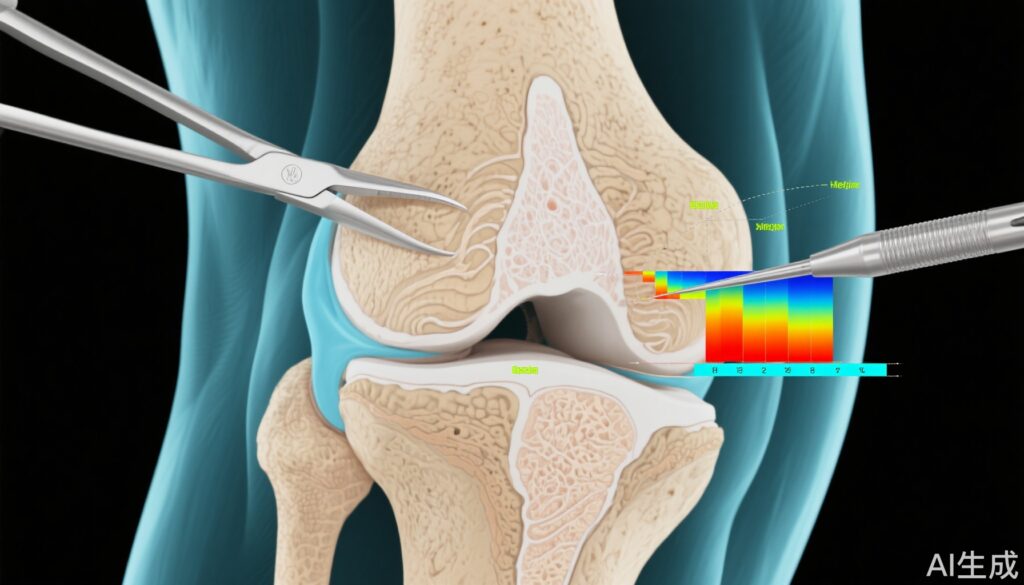Highlight
- Medial opening wedge high tibial osteotomy (HTO) significantly reduced medial tibiofemoral cartilage loss over 2 years compared to nonsurgical management alone.
- HTO provided clinically meaningful improvements in patient-reported outcomes (KOOS) for knee osteoarthritis with varus alignment.
- The study used blinded MRI assessment of cartilage thickness and included a parallel preference arm to enhance generalizability.
- Findings support HTO as a joint-preserving intervention for selected patients with medial compartment knee osteoarthritis.
Background
Knee osteoarthritis (OA) remains a leading cause of pain and disability, particularly in older adults. Medial compartment OA is commonly associated with varus malalignment, which increases mechanical loading on the medial tibiofemoral joint, accelerating cartilage degradation. Traditional management includes physical therapy, weight loss, and analgesics, with total knee arthroplasty reserved for end-stage disease. However, there is a clinical need for effective joint-preserving interventions that can delay or prevent the need for joint replacement, particularly in relatively young or active patients.
Medial opening wedge HTO aims to correct varus alignment and redistribute joint loads, theoretically reducing disease progression and improving function. While widely practiced, robust evidence from randomized controlled trials regarding its structural and symptomatic benefits has been limited.
Study Overview and Methodological Design
This single-center, open-label, assessor-blinded randomized controlled trial (RCT) (ClinicalTrials.gov: NCT02003976) investigated the efficacy of medial opening wedge HTO combined with nonsurgical management versus nonsurgical management alone. A parallel preference arm was included for patients with strong treatment preferences, enhancing the real-world applicability of the findings.
A total of 145 adults with symptomatic medial compartment knee OA and varus alignment were enrolled at a tertiary care center. All participants underwent baseline and 2-year follow-up assessments. The intervention group received HTO alongside a program of supervised therapeutic exercise (3 months), nutrition counseling, and as-needed use of acetaminophen or NSAIDs. The control group received the same nonsurgical management without HTO.
The primary endpoint was the 2-year change in medial tibiofemoral cartilage thickness, measured by masked 3-Tesla MRI. A 6.3% loss was set as the minimal clinically important difference (MCID). The key secondary endpoint was the change in the total Knee Injury and Osteoarthritis Outcome Score (KOOS), with a 10-point change considered clinically meaningful.
Key Findings
At 2 years, 83% of randomized participants and 88% of those in the preference arm completed assessments. In the randomized arm, mean cartilage thickness loss was −0.07 mm (2%) in the HTO group versus −0.25 mm (9%) in the control group—a between-group difference of 0.18 mm (95% CI, 0.18 to 0.19 mm). This difference exceeded the MCID, indicating a clinically significant slowing of cartilage deterioration in the HTO group.
For the KOOS, the mean improvement was 24.95 points in the HTO group versus 9.06 points in controls, for a mean difference of 15.89 points (95% CI, 8.94 to 22.84 points), again surpassing the MCID. Similar benefits were observed in the preference arm, supporting the robustness of the findings.
Clinical Implications
Findings from this trial support the use of medial opening wedge HTO as a disease-modifying, joint-preserving intervention for appropriately selected patients with medial compartment OA and varus alignment. In clinical practice, HTO should be considered for patients with symptomatic medial OA, varus malalignment, and preserved lateral compartment integrity who are motivated for surgical intervention and rehabilitation. Reliable cartilage preservation and symptomatic improvement may delay or obviate the need for knee arthroplasty in suitable candidates.
The inclusion of a parallel preference arm enhances the generalizability of the results, addressing common concerns about patient selection and real-world applicability.
Limitations and Controversies
The single-center nature of the study may limit generalizability to other healthcare settings. Although the study used assessor-blinded outcomes and robust radiological endpoints, open-label treatment may introduce performance bias. Long-term durability beyond 2 years remains to be established, and risks of surgical complications, including infection and nonunion, should be discussed with patients. Further multicenter and longer-term studies are warranted.
Controversy persists regarding the optimal timing of HTO, patient selection criteria, and comparative effectiveness against other surgical or biologic options. Cost-effectiveness analyses and studies integrating patient-reported outcomes with imaging biomarkers will be valuable.
Expert Commentary or Guideline Positioning
Current guidelines from the Osteoarthritis Research Society International (OARSI) and American Academy of Orthopaedic Surgeons (AAOS) acknowledge the potential role of HTO in younger, active patients with unicompartmental OA and malalignment. This trial provides Level I evidence supporting these recommendations and may encourage broader adoption in appropriate populations.
Conclusion
This rigorously conducted randomized trial demonstrates that medial opening wedge HTO slows medial cartilage loss and improves clinical outcomes over 2 years in patients with medial compartment knee OA and varus alignment. The study reinforces HTO as a valuable joint-preserving option for select patients, but longer-term data and broader multicenter validation are needed to confirm its place in the treatment algorithm.
References
1. Birmingham TB, Primeau CA, Moyer RF, Bryant DM, Ma J, Leitch KM, Wirth W, Degen R, Getgood AM, Litchfield RB, Willits KR, Eckstein F, Giffin JR. High Tibial Osteotomy for Medial Compartment Knee Osteoarthritis: A Randomized Trial With Parallel Preference Arm. Ann Intern Med. 2025 Jul 29. doi: 10.7326/ANNALS-25-00920 IF: 15.2 Q1 .2. American Academy of Orthopaedic Surgeons. Management of Osteoarthritis of the Knee (Nonarthroplasty). Evidence-Based Clinical Practice Guideline. 2021.
3. Hunter DJ, et al. Pathogenesis of osteoarthritis. Med Clin North Am. 2021 Jan;105(1):29-43.



